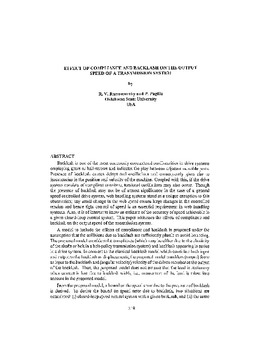| dc.contributor.author | Ramamurthy, R. V. | |
| dc.contributor.author | Pagilla, P. | |
| dc.contributor.other | International Conference on Web Handling (2005) | |
| dc.date.accessioned | 2019-11-08T22:56:57Z | |
| dc.date.available | 2019-11-08T22:56:57Z | |
| dc.date.issued | 2005-06 | |
| dc.identifier | oksd_icwh_2005_ramamurthy | |
| dc.identifier.citation | Ramamurthy, R. V., & Pagilla, P. (2005, June). Effect of compliance and backlash on the output speed of a transmission system. Paper presented at the Eighth International Conference on Web Handling (IWEB), Stillwater, OK. | |
| dc.identifier.uri | https://hdl.handle.net/11244/321894 | |
| dc.description.abstract | Backlash is one of the most commonly encountered nonlinearities in drive systems employing gears or ball-screws and indicates the play between adjacent movable parts. Presence of backlash causes delays and oscillations and consequently gives rise to inaccuracies in the position and velocity of the machine. Coupled with this, if the drive system consists of compliant members, torsional oscillations may also occur. Though the presence of backlash may not be of utmost significance in the case of a general speed controlled drive system, web handling systems stand as a unique exception to this observation; any small change in the web speed causes large changes in the controlled tension and hence tight control of speed is an essential requirement in web handling systems. Also, it is of interest to know an estimate of the accuracy of speed achievable in a given closed-loop control system. This paper addresses the effects of compliance and backlash on the output speed of the transmission system. | |
| dc.description.abstract | A model to include the effects of compliance and backlash is proposed under the assumption that the collisions due to backlash are sufficiently plastic to avoid bouncing. The proposed model considers the compliance (which may be either due to the elasticity of the shafts or belt in a belt-pulley transmission system) and backlash appearing in series in a drive system. In contrast to the classical backlash model which considers both input and output to the backlash as displacements, the proposed model considers (torque) force as input to the backlash and (angular velocity) velocity of the driven member as the output of the backlash. Thus, the proposed model does not assume that the load is stationary when contact is lost due to backlash width, i.e., momentum of the load is taken into account in the proposed model. | |
| dc.description.abstract | From the proposed model, a bound on the speed error due to the presence of backlash is derived. To derive the bound on speed error due to backlash, two situations are considered: (i) closed-loop speed control system with a given backlash, and (ii) the same closed-loop system with no backlash. The difference between the outputs of these two systems indicates the error caused by the backlash and represents the achievable accuracy of the closed-loop system. Closed-loop experiments were conducted on a rectilinear system to obtain the error caused by different backlash widths. The bound obtained from the experimental results agrees with the theoretically computed bound. | |
| dc.format | application/pdf | |
| dc.language | en_US | |
| dc.publisher | Oklahoma State University | |
| dc.rights | In the Oklahoma State University Library's institutional repository this paper is made available through the open access principles and the terms of agreement/consent between the author(s) and the publisher. The permission policy on the use, reproduction or distribution of the article falls under fair use for educational, scholarship, and research purposes. Contact Digital Resources and Discovery Services at lib-dls@okstate.edu or 405-744-9161 for further information. | |
| dc.title | Effect of compliance and backlash on the output speed of a transmission system | |
| osu.filename | oksd_icwh_2005_ramamurthy.pdf | |
| dc.description.department | Mechanical and Aerospace Engineering | |
| dc.type.genre | Conference proceedings | |
| dc.type.material | Text | |
